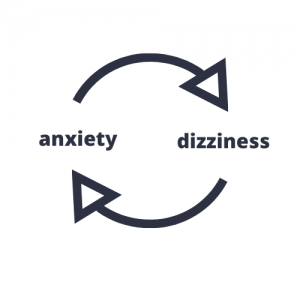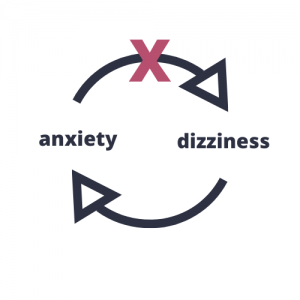Anxiety & Dizziness
Let’s face it, being dizzy can be really scary, and therefore, really anxiety provoking. Anxiety and dizziness go hand-in-hand, when I talk to my patients about this, I compare them to best friends. They love to be around each other, they relate to each other, and when one acts the other reacts. It creates a cycle that goes around and around, usually until the dizziness stops. Vestibular disorders, although invisible to others, cause real physical symptoms of dizziness. These symptoms provoke anxiety and frequently cause anxious behavior, and for patients with vestibular dysfunction this is normal. For those with anxiety surrounding their vestibular disorder, we can work together in physical therapy to treat the root cause.

Symptoms & Diagnosis
Dizziness related to anxiety can be a result of another kind of dizziness or vertigo that then feeds on your anxiety symptoms. Alternatively your dizziness can be a result of an anxiety disorder. However, in most cases I find that my patients have a combination of both happening. The most difficult thing for patients is often breaking your cycle of dizziness and anxiety.
Treatment
Because your dizziness and anxiety cause each other, we need to break the cycle in one or the other. If your dizziness has a root cause, like BPPV or Vestibular Neuritis, we can treat the source of your dizzy symptoms, hopefully relieving some or all of your anxiety. To treat these, we can use exercises for you
Vestibular Ocular Reflex (VOR), an Epley maneuver, or optokinetic stimulation. If anxiety is increasing your symptoms, or is the source of your symptoms, we need to find you a way to stop those feelings. Treatments to help decrease feelings of dizziness and anxiety are meditation, cognitive behavioral therapy, and grounding.
Physical Therapy
Physical therapy is a vital part of your journey toward dizziness relief, your vestibular therapist can help through a variety of treatments. One way to help anxiety through physical therapy is called grounding. There are a few ways you can do grounding, but my favorite is performed in a nice arm chair; if you don’t have an armchair, you can use a chair without arms as well! This kind of grounding is specifically for those with dizziness. Step one (1) sit in a big, sturdy chair, with your feet on the floor and arms on the arms of your chair. Step two (2) place 1 hand on your belly and the other on your chest; breathe diaphragmatically into your stomach. Step three (3) shut your eyes and begin to feel how still your body is. Start at your feet, feel how still the floor is; next feel the back of your legs on your chair and how still you are. Repeat with your arms, back, and maybe even your head! Continue to breathe deeply and evenly into your diaphragm. Continue this for 5-10 minutes until your anxiety and dizziness symptoms decrease.
Your physical therapist may recommend grounding, or may recommend another form of treatment to help with your anxiety. These may include a referral to a therapist or counselor, dietary recommendations and considerations, or vestibular exercises to treat the root of the issue. A discussion of a well-rounded, holistic plan specifically for you is the best way to act on your anxiety and break the cycle.
PS: if you made it to the end of this article and you’re in the holiday challenge, send me a DM for 2 extra points!


2 thoughts on “Anxiety & Dizziness”
Love this. I’m going to try it!
So excited!!